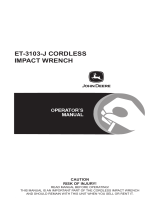
2
TABLE DES MATIERES
ÍNDICE
Français
Español
CONTENTS
English
Página
MONTAJE Y OPERACIÓN ...................................... 61
APLICACIONES ................................................... 61
MÉTODO DE EXTRACCIÓN E INSTALACIÓN
DE LA BATERÍA............................................ 61
MÉTODO DE CARGA .......................................... 61
ANTES DE LA UTILIZACIÓN .............................. 64
ANTES DE LA OPERACIÓN ................................ 64
COMO USAR LA SIERRA SABLE
A BATERÍA ................................................... 67
MANTENIMIENTO E INSPECCIÓN ........................ 71
ACCESORIOS........................................................... 74
ACCESORIOS ESTÁNDAR ................................. 74
ACCESORIOS OPCIONALES .............................. 75
LISTA DE PIEZAS .................................................... 76
Página
INFORMACIÓN IMPORTANTE SOBRE SEGURIDAD
.. 51
SIGNIFICADO DE LAS PALABRAS DE SEÑALIZACIÓN
.. 51
SEGURIDAD............................................................. 52
NORMAS GENERALES DE SEGURIDAD – PARA TODAS
LAS HERRAMIENTAS ALIMENTADAS CON BATERÍA
.. 52
NORMAS Y SÍMBOLOS ESPECÍFICOS DE SEGURIDAD
.... 54
INSTRUCCIONES IMPORTANTES PARA LA
UTILIZACIÓN DEL SIERRA SABLE
A BATTERÍA
................................................... 55
INSTRUCCIONES IMPORTANTES DE SEGURIDAD
PARA EL CARGADOR DE BATERÍAS
.................. 56
INSTRUCCIONES IMPORTANTES DE SEGURIDAD
PARA LA BATERÍA Y EL CARGADOR DE BATERÍAS
... 57
ADVERTENCIA DE LA BATERÍA DE LITIO......... 58
DESCRIPCIÓN FUNCIONAL.................................... 59
NOMENCLATURA............................................... 59
ESPECIFICACIONES............................................ 60
Page
IMPORTANT SAFETY INFORMATION .............. 3
MEANINGS OF SIGNAL WORDS ...................... 3
SAFETY .................................................................... 4
GENERAL SAFETY RULES – FOR ALL
BATTERY OPERATED TOOLS..................... 4
SPECIFIC SAFETY RULES AND SYMBOLS ....... 6
IMPORTANT SAFETY INSTRUCTIONS FOR USE
OF THE CORDLESS RECIPROCATING SAW
.... 7
IMPORTANT SAFETY INSTRUCTIONS
FOR BATTERY CHARGER ............................. 8
IMPORTANT SAFETY INSTRUCTIONS
FOR USE OF THE BATTERY AND
BATTERY CHARGER...................................... 9
CAUTION ON LITHIUM-ION BATTERY ............. 10
FUNCTIONAL DESCRIPTION.................................. 11
NAME OF PARTS ......................................... 11
SPECIFICATIONS ......................................... 12
Page
ASSEMBLAGE ET FONCTIONNEMENT ................ 37
APPLICATIONS ................................................... 37
MÉTHODE DE RETRAIT ET D’INSTALLATION
DE LA BATTERIE .......................................... 37
MÉTHODE DE RECHARGE ................................. 37
AVANT L’UTILISATION ...................................... 40
AVANT L’OPERATION ........................................ 40
COMMENT UTILISER LA SCIE
ALTERNATIVE À BATTERIE ........................ 43
ENTRETIEN ET INSPECTION .................................. 46
ACCESSOIRES ......................................................... 49
ACCESSOIRES STANDARD ............................... 49
ACCESSOIRES SUR OPTION ............................. 50
LISTA DES PIÈCES .................................................. 76
Page
ASSEMBLY AND OPERATION ............................... 13
APPLICATIONS ................................................... 13
REMOVAL AND INSTALLATION METHOD
OF BATTERY ................................................ 13
CHARGING METHOD ......................................... 13
BEFORE USE ....................................................... 16
PRIOR TO OPERATION ....................................... 16
HOW TO USE THE CORDLESS
RECIPROCATING SAW................................ 19
MAINTENANCE AND INSPECTION ....................... 22
ACCESSORIES ......................................................... 25
STANDARD ACCESSORIES ............................... 25
OPTIONAL ACCESSORIES ................................. 26
PARTS LIST.............................................................. 76
Page
INFORMATIONS IMPORTANTES DE SÉCURITÉ
...... 27
SIGNIFICATION DES MOTS D’AVERTISSEMENT
.... 27
SECURITE ................................................................ 28
REGLES GENERALE DE SECURITE – POUR TOUS
LES OUTILS FONCTIONNANT SUR BATTERIE
... 28
REGLES DE SECURITE SPECIFIQUES ET SYMBOLES
.... 30
CONSIGNES DE SÉCURITÉ IMPORTANTES POUR
L'UTILISATION DU SCIE ALTERNATIVE À BATTERIE
.. 31
CONSIGNES DE SÉCURITÉ IMPORTANTES
POUR LE CHARGEUR DE BATTERIE .......... 32
CONSIGNES DE SÉCURITÉ IMPORTANTES POUR L’UTILISATION
DE LA BATTERIE ET DU CHARGEUR DE BATTERIE
........... 33
PRÉCAUTIONS RELATIVES A LA BATTERIE AU
LITHIUM ION ................................................ 34
DESCRIPTION FONCTIONNELLE ........................... 35
NOM DES PARTIES ............................................ 35
SPECIFICATIONS ................................................ 36





















